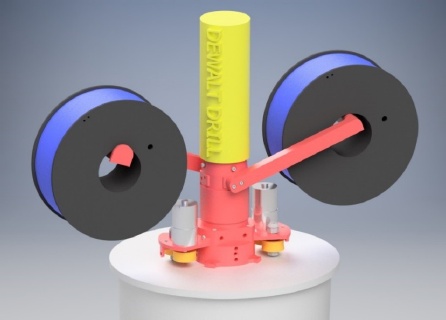Good filament can be pricey, although the polymers the filament is made from aren’t that expensive. That’s the opening observation of a paper entitled “3-D Printable Polymer Pelletizer Chopper for Fused Granular Fabrication-Based Additive Manufacturing.” The authors argue that the markup can be avoided by eliminating the process of creating filament and instead 3D printing directly from polymer granules. Fused granular fabrication (FGF), or fused particle fabrication (FPF), they point out, is held back by the lack of accessibility to low-cost pelletizers and choppers. So they developed their own open-source 3D printable pelletizer that can process both single thermopolymers as well as composites.
After assembling the machine, the researchers tested it with a number of materials: both 1.75 and 2.85 diameter PLA and ABS, as well as PP, PETg and coffee-filled PLA. They also tested NinjaFlex, but found that it was too flexible to be processed.
A prototype Gigabot X 3D printer was used to 3D print the materials, and a self-designed “recyclebot” was used to create PLA filament from the pellets.
“The system could control the particle size by changing the speed,” the researchers state. “…The pellet production rate in kg/h is a function of speed of the motor and is linear: 0.5 kg/h at full speed with one motor, 0.25 at 100 rpm, and 0.125 at 50 rpm.”
Recycled material, such as PET and PP, can also be used from post-consumer materials, chopping up things like water bottles.
“To maintain acceptable mechanical properties, the recycled filament must be blended with virgin materials or reinforced with more robust materials,” the researchers explain. “Despite these drawbacks, a life cycle analysis of materials processed with a recyclebot found a 90% decrease in the embodied energy of the filament compared to traditional filament manufacturing.”
Thermopolymers that have been shown to be acceptable for the recyclebot process include PLA, HDPE, ABS and elastomers, as well as composites such as waste wood biopolymers and carbon fiber-reinforced plastics.
Future work includes replacing some parts such as the DC motor with cheaper alternatives, as well as working on geometric improvements that would allow flexible filaments such as NinjaFlex to be chopped.
“The system was successfully developed using open-source design strategies and fabricated using low-cost open-source 3-D printers,” the researchers conclude. “The invention provided high-tolerance thermopolymer pellets with a number of sizes capable of being used in an FGF printer as well as for recyclebot reformulation of 3-D printing filament. It has a 0.5 kg/h throughput with one motor,and a 1.0 kg/h throughput with two motors using only 0.24 kWh/kg during the chopping process. Pellets were successfully 3-D printed directly via FGF, as well as indirectly after being converted into high-tolerance filament in a recyclebot.”
Authors of the paper include Aubrey L Woern and Joshua Pearce.
Discuss this and other 3D printing topics at 3DPrintBoard.com or share your thoughts below.
